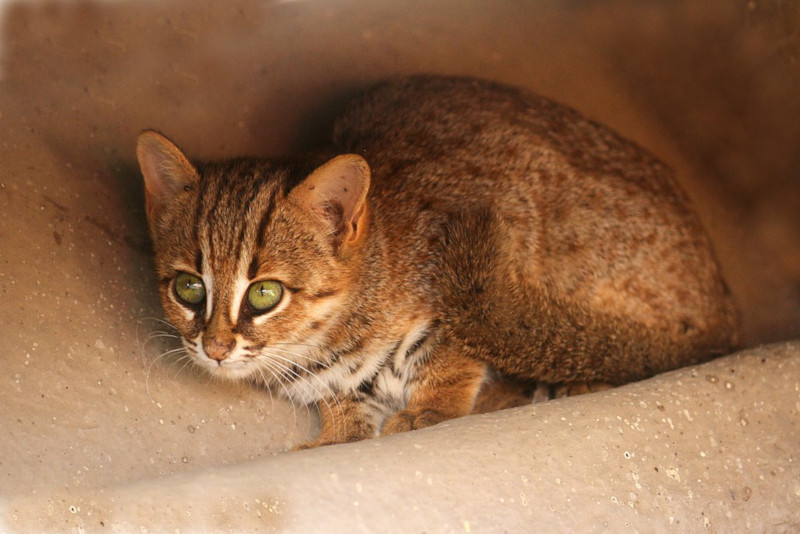
Rusty-Spotted Cat Facts
- The intriguing yet undeniably descriptive term of Rusty-Spotted Cat serves as the most frequently used common name for this beautiful wild feline. Yet, it does have at least one other general title that it’s known by. That’s the extremely similar name of Rusty-spotted wildcat.
- Within the halls of science, however, the animal’s perhaps much better known by its entirely technical designation. Unfortunately, like many such tags, that’s one that remains somewhat difficult for the layperson to pronounce. It holds the formal moniker Prionailurus rubiginosus.
- This marvel of Nature and evolution received that epithet following the efforts of Isidore Geoffroy Saint-Hilaire. That highly respected Frence zoologist accomplished the first formal recognition of it as a separate and distinct species. She achieved that noteworthy feat in 1831.
- However, at that time, the eminent researcher provided the stunning mammal with an entirely different tag than the one it holds currently. Subsequent to her original taxonomic work, other researchers later proposed alternate official honorifics, until the one it holds presently.
- Sadly, like many of the species of the world, the stunning Rusty-Spotted Cat now finds itself in peril. Its population numbers appear to be dwindling rapidly, for various reasons. As a result, the IUCN now lists the mammal as Near Threatened on its Red List of Threatened Species.
- For the moment, habit loss appears to be the primary factor behind its decline. This occurs mainly due to its native habit being destroyed as part of cultivation efforts by humans. It also, however, now faces the threat of ongoing climate change, like all other species on earth today.
Related Articles
Rusty-Spotted Cat Physical Description
The fabulous Rusty-Spotted Cat elegantly proves the principle that beauty comes in all shapes and sizes among the earth’s fauna. That’s because, by any measure, it’s a small species of feline, despite its great appeal. Nature continually demonstrates its apparent love of variety in its creations.
Following the evolutionary pattern common to many mammals, though, this amazing variety of feline displays the physiological characteristic of sexual dimorphism. It also follows the pattern of the majority of felines in that this trait primarily manifests itself in terms of sheer physical size.
More precisely, the males of the species attain a greater average body weight than the females. That difference, however, remains comparatively minor. A male reaches an average body weight of roughly 3.75 lb (1.7 kg.) The slightly smaller female, meanwhile, averages about 3.1 lb (1.4 kg).
In terms of overall appearance, though, the genders appear essentially indistinguishable to the casual observer. Typically, the fur develops as quite short, and mainly displays a brownish color across most of the body of the animal. It further shows a mild rusty tinge, hence the common name.
The animal does, though, present a different pattern on the throat and the underside of the body. There, the fur develops as a light white in color. It’s also marked with random dark stripes and spots. Typically, individuals also have four markedly dark stripes extending back from over the eyes.
- Kingdom: Animalia
- Phylum: Chordata
- Class: Mammalia
- Order: Carnivora
- Family: Felidae
- Genus: Prionailurus
- Species: P. rubiginosus
Rusty-Spotted Cat Distribution, Habitat, and Ecology
Lamentably, the Rusty-Spotted Cat only appears to inhabit a very small portion of the surface of the globe. In this instance, that region covers a tiny section of the continent of Asia. More specifically, the only known habitat range of the animal consists of portions of Sri Lanka and India.
Its main habitat qualifies as very specific in nature. The majority of individuals appear in regions of relatively dry forests. In recent years, however, small groups have begun to appear in agricultural areas inhabited by humans. The exact reason for this currently still remains unknown.
Yet, its impressive degree of adaptability does not end there. Perhaps in response to increasing human encroachment on its natural territory, groupings now appear to be expanding their zone of habitation. In fact, a few scattered individuals now even inhabit both tropical and semi-arid areas.
Evidence further indicates that the fascinating Rusty-Spotted Cat evolved as a mainly solitary animal. Most individuals live alone, and usually remain within clearly defined personal territories. Although mainly terrestrial in nature, it also displays tendencies toward arboreal activities.
Like its many related species around the world, this mammal also evolved as carnivorous in nature. Given its size, its prey typically consists of smaller creatures. This largely consists of small birds and other mammals. Yet it also feeds opportunistically, including eating insects such as crickets.
Somewhat surprisingly for researchers, this intrepid wonder appears to have no natural predators. It must be pointed out, however, that detailed studies of its habits and life cycle remain few, at least for the moment. Most likely, it falls prey to a variety of larger carnivores sharing its native range.
Species Sharing Its Range
Check out our other articles on 4 Magnificent Land Mammals of Mexico, Bowmouth Guitarfish, Namib Desert, Japanese Hare, Arrowleaf Elephant Ear, Conehead Mantis, Jackson’s Chameleon
